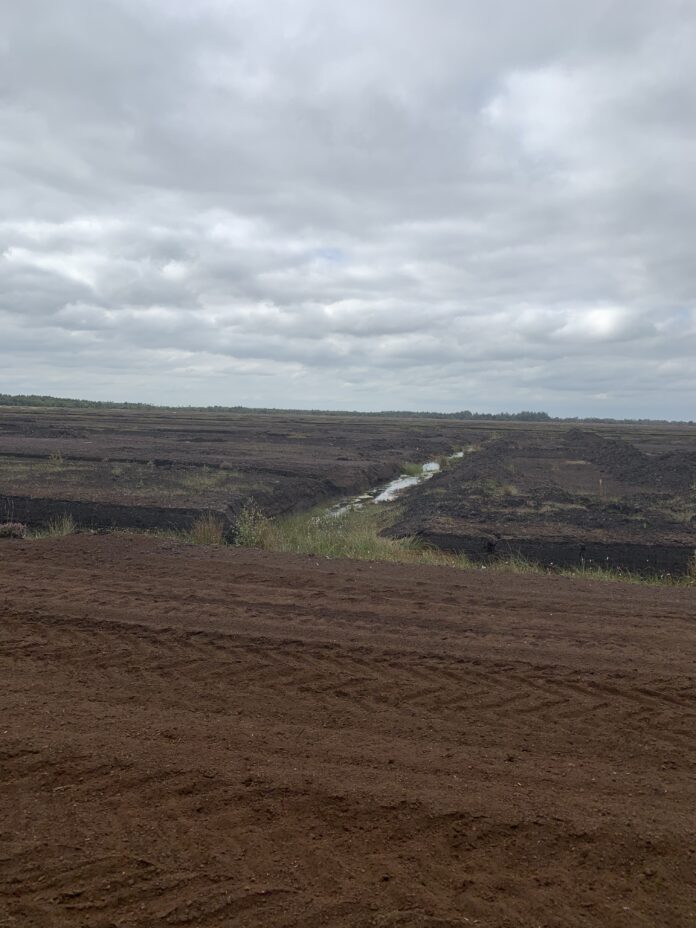Noeleen Smyth addresses the urgent need to take action on Ireland’s lost bog-lands
One of our favorite family tunes is the ‘Rattlin Bog’. The kids love the meandering, memory-melting verses, and growing up in Kildare we have watched that “hole in the Bog” of Allen get bigger and bigger. We have sat through many chats and discussions on what’s going to happen to that “hole in the bog” and have not been pleased with what we have seen so far, but that’s a story for another day.
As a nation, we don’t often jump into action, but one of the quickest and most controversial decisions ever made was in 2019, with regard to peat harvesting. A high court decision effectively ended commercial peat harvesting in Ireland. This very abrupt decision has left an entire industry scrambling for supplies. The crazy situation we find ourselves in now is that we are importing Balkan peat to meet industry needs, creating another “hole” in another “rattlin” (which apparently means splendid) bog in another part of the world.
WHY ARE WE IN THIS DIRE SITUATION?
On a recent visit to some cut-over bogs, near Allenwood in Co Kildare, I chatted to a retired Irish Peatland Ecologist. I explained that I had been trying to get my head around how we ended up in such dire straits. He, even more depressingly, told me that we had the choice many years ago to opt for a more sustainable harvest of peat with a “Canadian” approach. In this method, peat moss is harvested continuously and yet still does not contribute to a decline in their peat bogs, as they allow millions of tonnes of peat to accumulate while harvesting, only ever utilising a small percentage of it. The Canadians manage harvesting sites in a sustainable way, never completely mining away the resource. The living Sphagnum peat cap is replaced after harvest and they don’t harvest down to marl, instead of leaving a harvested site fully functional for the future. Sounds very logical and sensible, doesn’t it? Sadly we didn’t take that approach here in Ireland, and now, with our peat resource almost dwindling away to nothing, we are at a point of no return. Sphagnum peats could have been harvested in a very sustainable way.
Peat is made from the moss genus Sphagnum and Sphagnum loves to grow here in Ireland. The mild Atlantic climate really suits them. We are a European stronghold for this genus with 33 of the 55 species of Sphagnum found here. However, despite loving to grow here, a recent conservation assessment conducted under Article 17 of the EU Habitats and Species Directive found that the status of Sphagnum was “inadequate.” Just four percent, or 50k hectares, of our peat-forming “active raised bogs” remain. With the drastic decline of our bogs comes the drastic decline of our peat-forming Sphagnum species, which are becoming even rarer as the habitat declines (NPWS 2019).
The horticultural industry is hooked and totally reliant on peat compost and there are currently no truly viable alternatives. According to Growing Media Ireland, alternatives have been trialed, including green waste, bark, and coconut fibre. They have all been assessed as falling short in terms of quality, health and safety, and carbon footprint.
WHERE DO WE GO FROM HERE?
Sphagnum moss grows so well here in Ireland that it is, in theory, a perfectly renewable resource when managed. However, we opted for extensive ‘open-pit mining’ of peat, splitting open and draining our active raised bogs and harvesting every millimeter of peat until now we are left with the “brown deserts.” So much so that in many cases we have mined our bogs right back to the ice age.
The ‘holy grail’ now is to see if we can build back our bogs, putting Sphagnum on our cutover bogs and hoping it will grow again. If it could grow on our bogs again, then we have the potential to both build a renewable resource for industry, and return them to their function as a carbon store. Is this even possible? The very short answer is “yes,” the potential is definitely there, but it is still a massive challenge as the water levels need to be managed very precisely to do this. The word of the moment is ‘paludiculture’, or trying to get biomass growing on wet organic soils.
On one of the sites I visited with the group, we went to see a small experimental section of cut-over bog where Sphagnum had been planted as a trial in 2015. There was a very small percentage success rate and only one site with definite regeneration from Sphagnum-planted plugs. The Sphagnum planted were also being sourced from the UK, though the source material was Irish (not sensible or sustainable). As the European stronghold for the species, Ireland technically should be the source of Sphagnum for restoration schemes. Sphagnum have been recorded growing as much as 40cm a year. The net production of dry matter is comparable to that of other plants and may be 50% more than grassland under optimal conditions (Feehan & O Donovan 1996). Great stories exist of a boat being pulled out of a bog where an old man remembers fishing as a boy on an open lake. If we get the water conditions right on our cutover bogs, then yes, we can grow Sphagnum.
WHY PURSUE THESE CUTOVER SITES?
We have to do something. We are so far down the road towards a planet tipping point, with regard to CO2 and global temperature increases, that doing nothing is not an option. These ‘brown deserts’ are now emitting huge amounts of CO2. “CO2 emissions from drained peatlands are estimated at 1.3 gigatonnes annually. This is equivalent to over 5% of the global people linked CO2 emissions,” according to the IUCN. A statistic from 2015 records that one fire on an Indonesian peatland emitted nearly 16 million tonnes of CO2, which equated to more than the daily emissions from the entire US economy. We can’t risk the fires or continue to abandon our cutover bogs as it will send our emissions through the roof. We would end up paying more.
COULD WE REGROW OUR BOGS AND SUPPLY AN INDUSTRY?
It’s very tantalising to think that all we need do is get Sphagnum growing again on these cutover bogs. If this is accomplished then we can really start doing something huge for the horticulture industry and the planet. From a planet perspective growing Sphagnum is a great idea. The remaining area of near-natural peatland (>3 million km2) contains more than 550 gigatonnes of carbon, representing 42% of all soil carbon and exceeding the carbon stored in all other vegetation types, including the world’s forests. This area sequesters 0.37 gigatonnes of CO2 a year, active bogs with growing Sphagnum are fabulous at storing Carbon.
We already see the potential for Sphagnum farming in Ireland, though the field experiments to date on cut-over bogs have proven to be challenging and with mixed results (McCorry pers. Comm). We have a long way to go and a lot of research work to do. The National Botanic Gardens already grow Sphagnum for demonstration with the ‘bog in a box’ method, showing that Sphagnum grows very well in shallow troughs. However, we need to make a bigger effort to conserve and salvage the valuable and irreplaceable resources of our 33 Sphagnum species. I suggest that we grow them all and select the fastest and most suitable species for cropping to produce composts from. While I was at the National Botanic Gardens we had already started to dabble with growing rare and threatened mosses in culture. One of my Ph.D. students, Christina Campbell, completed her thesis on the subject in 2013. We know the techniques required to grow them at a small scale and we can go bigger. Various other methods and species have already been trialed abroad, with great success (Gaudig et al. 2018, Pouliot et al. 2015).
So, we are at a crossroads. We have the huge potential here to truly be green, save our very special Sphagnum species, to fill in that ‘hole in the bog’ with the ‘rare seeds’ — rare Sphagnum in our case — and to stop our cutover bogs emitting carbon. We can also commercially grow a suitable, fully sustainable, and renewable compost material for horticulture from Irish Sphagnum. Let’s get out of our own way and start to think logically and clearly about the future of our currently very finite resource-active raised peat bogs before it’s too late. We have a very big ‘hole’ in the bog. We need to stop the harvest and make sure that we can save the species that build the bogs. Then we can ‘build back better’ and make sensible decisions for the growers and composts of the future, to secure our food supply. Our very precious 33 Sphagnum or ‘bog builders’ are the ‘green gold’ and ‘seeds’ for future bogs. Let’s save what we have left. ✽

Noeleen Smyth is an Assistant Professor in Envirmonmental Horticulture at University College Dublin. She holds a PhD. and Hons Degree in Botany from Trinity College Dublin and diplomas in Horticulture from Teagasc and RHS. She is a Biodiversity and conservation specialist. As part of her current role, she acts as the CITES Scientific Authority for Ireland, advising the government on rare plant imports. |





